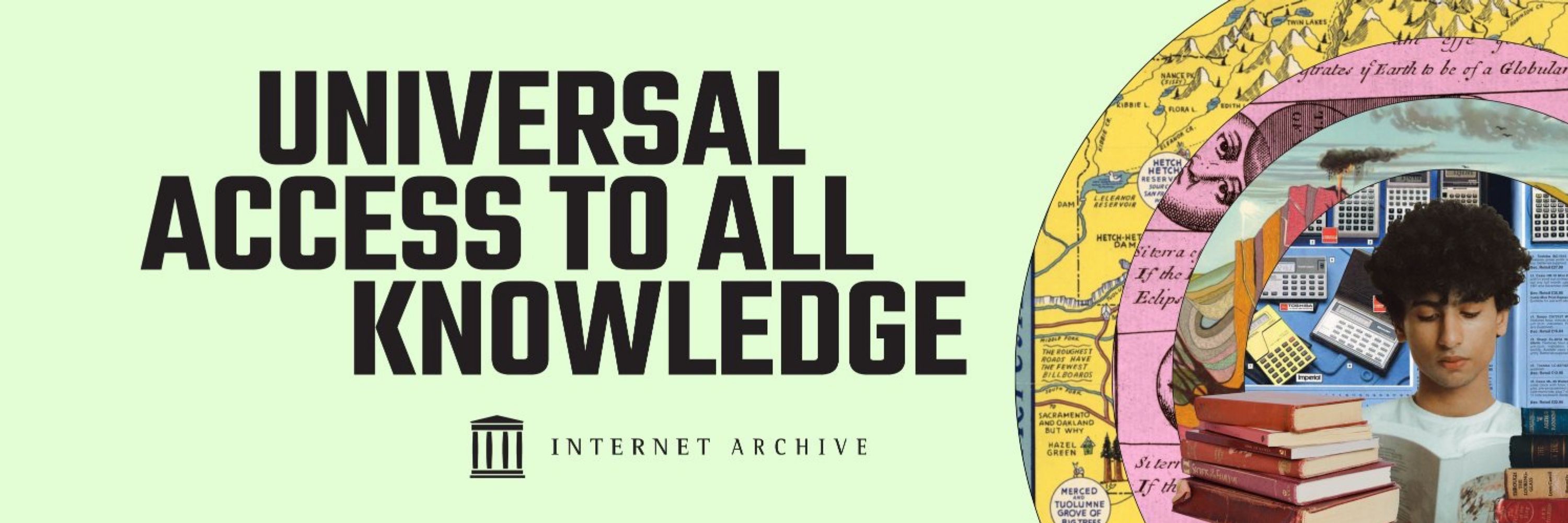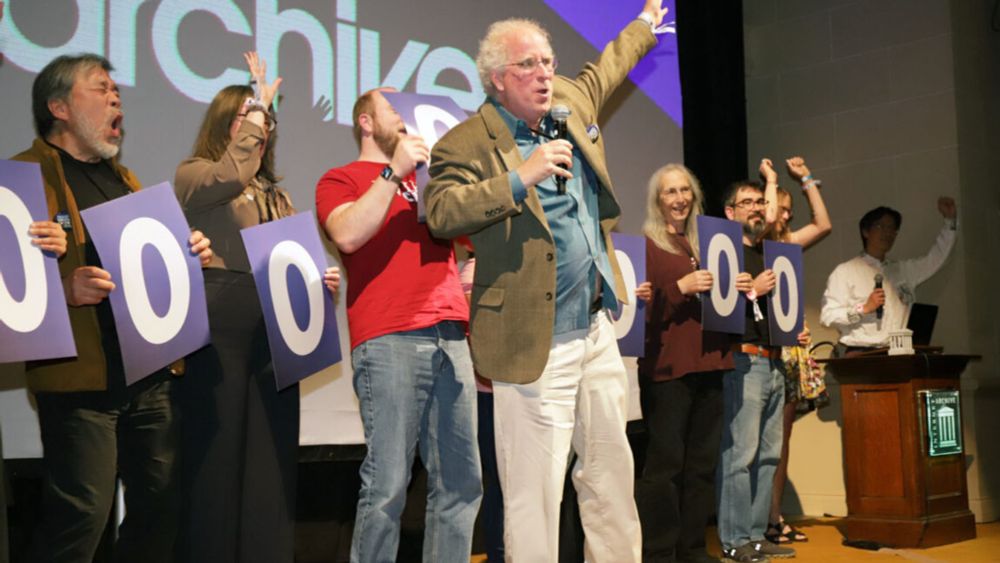

After years of legal battles, the Internet Archive is still here—and still fighting for a world where everyone can read, learn, and remember.
@arstechnica.com tells the story: arstechnica.com/tech-policy/...
Join Samuel Moore & Heather Joseph for PUBLISHING BEYOND THE MARKET, reimagining open access through scholar-led, non-commercial publishing.
📆 Thurs Dec 4th
🕙 10 AM PT / 1 PM ET
📍 Online
🎟️ www.eventbrite.com/e/1839631951...
@SamuelMoore.org @HJoseph.bsky.social

Join Samuel Moore & Heather Joseph for PUBLISHING BEYOND THE MARKET, reimagining open access through scholar-led, non-commercial publishing.
📆 Thurs Dec 4th
🕙 10 AM PT / 1 PM ET
📍 Online
🎟️ www.eventbrite.com/e/1839631951...
@SamuelMoore.org @HJoseph.bsky.social
📅 Nov 26
🕙 10–11 AM PT
📍 Online
🎟️ www.eventbrite.com/e/1974935071...
@getdweb.net

📅 Nov 26
🕙 10–11 AM PT
📍 Online
🎟️ www.eventbrite.com/e/1974935071...
@getdweb.net
More ➡️ blog.archive.org/2025/11/18/m...
@merrileeiam.bsky.social

More ➡️ blog.archive.org/2025/11/18/m...
@merrileeiam.bsky.social
We’re grateful to support journalists, researchers & fact-checkers everywhere.
🔗 poynter.org/commentary/2025/what-were-thankful-for-in-media-in-2025/

We’re grateful to support journalists, researchers & fact-checkers everywhere.
🔗 poynter.org/commentary/2025/what-were-thankful-for-in-media-in-2025/
📝 More ⤵️
blog.archive.org/2025/11/20/v...
#Wayback 1T #WebHistory #WaybackMachine
📝 More ⤵️
blog.archive.org/2025/11/20/v...
#Wayback 1T #WebHistory #WaybackMachine
Pay your respects ⤵️
archive.org/details/in-m...
#Wayback1T
Pay your respects ⤵️
archive.org/details/in-m...
#Wayback1T
The Wicked Witch used it first, then Dorothy.
🐒🪽More Oz in the #publicdomain ⤵️
blog.archive.org/2025/11/17/t...
#Oz #Wicked

The Wicked Witch used it first, then Dorothy.
🐒🪽More Oz in the #publicdomain ⤵️
blog.archive.org/2025/11/17/t...
#Oz #Wicked
en.wikipedia.org/wiki/Penstem...

en.wikipedia.org/wiki/Penstem...
🧙🏼Check out her earliest depictions in these images, & explore more Oz history on our blog ⤵️
blog.archive.org/2025/11/17/t...
#PublicDomain #Oz #Wicked

🧙🏼Check out her earliest depictions in these images, & explore more Oz history on our blog ⤵️
blog.archive.org/2025/11/17/t...
#PublicDomain #Oz #Wicked
Join us & Authors Alliance to learn why the internet broke & how we can fix it.
🕙 10 AM PT / 1 PM ET
📍 Online
🎟️ www.eventbrite.com/e/1839608451...
#enshittification

Join us & Authors Alliance to learn why the internet broke & how we can fix it.
🕙 10 AM PT / 1 PM ET
📍 Online
🎟️ www.eventbrite.com/e/1839608451...
#enshittification
We apologize and are working on it. More as it happens.
* @iua-official.bsky.social Librarians’ Group (IUALG)
* Boston Library Consortium
* @libraryfutures.bsky.social
🔗 Full announcement: www.internetarchive.eu/2025/11/21/t...
🔗 Promote the campaign: ourfuturememory.org
* @iua-official.bsky.social Librarians’ Group (IUALG)
* Boston Library Consortium
* @libraryfutures.bsky.social
🔗 Full announcement: www.internetarchive.eu/2025/11/21/t...
🔗 Promote the campaign: ourfuturememory.org
We apologize and are working on it. More as it happens.
We apologize and are working on it. More as it happens.
We apologize and are working on it. More as it happens.
Learn more about Oz in the #publicdomain ⤵️
blog.archive.org/2025/11/17/t...
#Oz #Wicked
Learn more about Oz in the #publicdomain ⤵️
blog.archive.org/2025/11/17/t...
#Oz #Wicked
archive.org/details/unco...
archive.org/details/unco...
In MUSIC AND COPYRIGHT IN THE ERA OF TAYLOR SWIFT, Michael Menna & Anjali Vats explore copyright’s ideals vs. realities on the Future Knowledge #podcast.
🎧 ⬇️
futureknowledge.transistor.fm/episodes/mus...
#taylorswift

In MUSIC AND COPYRIGHT IN THE ERA OF TAYLOR SWIFT, Michael Menna & Anjali Vats explore copyright’s ideals vs. realities on the Future Knowledge #podcast.
🎧 ⬇️
futureknowledge.transistor.fm/episodes/mus...
#taylorswift
More ⬇️
blog.archive.org/2025/11/17/v...
#Wayback1T @netmom.bsky.social
More ⬇️
blog.archive.org/2025/11/17/v...
#Wayback1T @netmom.bsky.social
📆 Fri Nov 21st
🕙 10 AM PT / 1 PM ET
📍 Online
🎟️ www.eventbrite.com/e/1839608451...
@AuthorsAlliance.bsky.social

📆 Fri Nov 21st
🕙 10 AM PT / 1 PM ET
📍 Online
🎟️ www.eventbrite.com/e/1839608451...
@AuthorsAlliance.bsky.social
📖 Learn more ⬇️
blog.archive.org/2025/11/17/t...
#PublicDomain #Oz #ClassicLiterature #LFrankBaum

Follow us for Public Domain Day 2026 announcements!
👀 Full cartoon ➡️ archive.org/details/stea...
#OTD #PublicDomain
Follow us for Public Domain Day 2026 announcements!
👀 Full cartoon ➡️ archive.org/details/stea...
#OTD #PublicDomain
Our second shift is live now (4 PM–Midnight PT).
📡 www.youtube.com/live/SxUjwZY...
#LiveNow #Preservation #LiveStream @Archive.org

Our second shift is live now (4 PM–Midnight PT).
📡 www.youtube.com/live/SxUjwZY...
#LiveNow #Preservation #LiveStream @Archive.org
📖 Learn more ⬇️
blog.archive.org/2025/11/17/t...
#PublicDomain #Oz #ClassicLiterature #LFrankBaum

📖 Learn more ⬇️
blog.archive.org/2025/11/17/t...
#PublicDomain #Oz #ClassicLiterature #LFrankBaum


